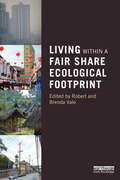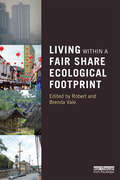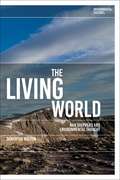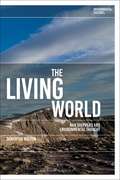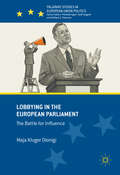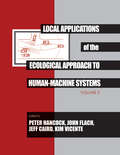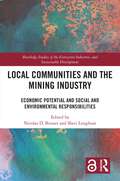- Table View
- List View
Living with the Earth, Fourth Edition: Concepts in Environmental Health Science
by Gary S. Moore Kathleen A. BellShelving Guide; Environmental ScienceThis is a groundbreaking and innovative book now in its fourth edition. The first edition won the CHOICE award for outstanding Academic Book while editions two and three became bestsellers on their own right. This fourth edition is packed with new updates on current world events associated with environmental issues and related health concerns. The author maintains traditional concepts and merges them with new and controversial issues. The book has been revised to include up-to-date topics with and a revised Web site with updated links.So what Coverage of emergency preparedness for environmental health practitioners Discussion of population dynamics especially with regard to overpopulation and underpopulation around the world and their respective influences on social, economic, and environmental concerns. The mechanisms of environmental disease, emphasizing genetic disease and its role in developmental disorders and cancer. Human behaviors and pollution are presented along with respect to their roles in cancer risk. The ever increasing issues surrounding emerging and re-emerging diseases around the earth and the introduction of an increasing number of emerging diseases. The growing problems of asthma and other health effects associated with air pollution. An exploration of the mechanisms of toxicity with special reference to the immune system and endocrine disruption. The ongoing issues of the creation and disposal of hazardous waste along with the controversies surrounding disposal are presented. The issues and benefits of recycling are explored. The use of HACCP in assuring food quality, food safety issues, and the Food Quality Protection Act are discussed. Numerous technical illustrations, charts, graphs, and photographs are included What on the Web? Test bank and study questions giving a complete review of the concepts covered. Search tools for online journals and databases covering useful, up-to-date information in health and environmental topics Subject specific links by chapter as well as Federal, state, and organization sites with relevant information Downloadable PowerPoint files for each Chapter providing the instructor with ready-made presentation materials that can be modified as needed. Downloadable and printable test questions and answers for each chapter available to instructors
Living with the Earth, Fourth Edition: Concepts in Environmental Health Science
by Gary S. Moore Kathleen A. BellShelving Guide; Environmental ScienceThis is a groundbreaking and innovative book now in its fourth edition. The first edition won the CHOICE award for outstanding Academic Book while editions two and three became bestsellers on their own right. This fourth edition is packed with new updates on current world events associated with environmental issues and related health concerns. The author maintains traditional concepts and merges them with new and controversial issues. The book has been revised to include up-to-date topics with and a revised Web site with updated links.So what Coverage of emergency preparedness for environmental health practitioners Discussion of population dynamics especially with regard to overpopulation and underpopulation around the world and their respective influences on social, economic, and environmental concerns. The mechanisms of environmental disease, emphasizing genetic disease and its role in developmental disorders and cancer. Human behaviors and pollution are presented along with respect to their roles in cancer risk. The ever increasing issues surrounding emerging and re-emerging diseases around the earth and the introduction of an increasing number of emerging diseases. The growing problems of asthma and other health effects associated with air pollution. An exploration of the mechanisms of toxicity with special reference to the immune system and endocrine disruption. The ongoing issues of the creation and disposal of hazardous waste along with the controversies surrounding disposal are presented. The issues and benefits of recycling are explored. The use of HACCP in assuring food quality, food safety issues, and the Food Quality Protection Act are discussed. Numerous technical illustrations, charts, graphs, and photographs are included What on the Web? Test bank and study questions giving a complete review of the concepts covered. Search tools for online journals and databases covering useful, up-to-date information in health and environmental topics Subject specific links by chapter as well as Federal, state, and organization sites with relevant information Downloadable PowerPoint files for each Chapter providing the instructor with ready-made presentation materials that can be modified as needed. Downloadable and printable test questions and answers for each chapter available to instructors
Living with the Unexpected: Linking Disaster Recovery to Sustainable Development in Montserrat
by Anja PossekelLiving with the Unexpected deals with complexity and uncertainty, two major challenges in a world faced with climate change and hazards. The study focuses on appropriate methods which enable vulnerable communities to cope effectively with natural hazards and disasters. The central goal of the book is an applicable combination of hazard management and development planning. Therefore, the reconstruction process following a disaster is understood as an opportunity for structural changes and self-organisation processes that foster sustainable development. In this context the potential of scenario planning as an evolutionary and participatory learning approach is addressed. The empirical research concentrates on the time before and during the volcanic crisis on the Caribbean Island Montserrat. Particular methods used are a systematic analysis of the complex system Montserrat, more than 200 interviews with stakeholders and citizens – concentrating on resource and hazard perceptions – as well as the organization and execution of various scenario workshops. The study shows that the opportunity to realise sustainable development on the island with the help of a participative, adaptive reconstruction process is better than ever. The population is sensitised to disasters and an uncertain future. Their preparedness to accept measures which are designed to reduce their vulnerability is high. This book demonstrates how we can learn to live with the Unexpeted.
Living with water: Everyday encounters and liquid connections
by Charlotte Bates Kate MolesLiving with water brings together sociologists, geographers, artists, writers and poets to explore the ways in which water binds, immerses and supports us. Drawing from international research on river crossings, boat dwelling, wild swimming, sea fishing, and drought impacts, and navigating urban waters, glacial lagoons, barrier reefs and disappearing tarns, the collection illuminates the ways that we live with and without water, and explores how we can think and write with water on land. Water offers a way of attending to emerging and enduring social and ecological concerns and making sense of them in lively and creative ways. By approaching Living with water from different disciplinary and methodological perspectives, and drawing on research from around the world, this collection opens up discussions that reinvigorate and renew previously landlocked debates.This book is relevant to United Nations Sustainable Development Goal 6, Clean water and sanitation
Living with water: Everyday encounters and liquid connections
by Charlotte Bates and Kate MolesLiving with water brings together sociologists, geographers, artists, writers and poets to explore the ways in which water binds, immerses and supports us. Drawing from international research on river crossings, boat dwelling, wild swimming, sea fishing, and drought impacts, and navigating urban waters, glacial lagoons, barrier reefs and disappearing tarns, the collection illuminates the ways that we live with and without water, and explores how we can think and write with water on land. Water offers a way of attending to emerging and enduring social and ecological concerns and making sense of them in lively and creative ways. By approaching Living with water from different disciplinary and methodological perspectives, and drawing on research from around the world, this collection opens up discussions that reinvigorate and renew previously landlocked debates.This book is relevant to United Nations Sustainable Development Goal 6, Clean water and sanitation
Living within a Fair Share Ecological Footprint
by Robert Vale Brenda ValeAccording to many authorities the impact of humanity on the earth is already overshooting the earth’s capacity to supply humanity’s needs. This is an unsustainable position. This book does not focus on the problem but on the solution, by showing what it is like to live within a fair earth share ecological footprint. The authors describe numerical methods used to calculate this, concentrating on low or no cost behaviour change, rather than on potentially expensive technological innovation. They show what people need to do now in regions where their current lifestyle means they are living beyond their ecological means, such as in Europe, North America and Australasia. The calculations focus on outcomes rather than on detailed discussion of the methods used. The main objective is to show that living with a reduced ecological footprint is both possible and not so very different from the way most people currently live in the west. The book clearly demonstrates that change in behaviour now will avoid some very challenging problems in the future. The emphasis is on workable, practical and sustainable solutions based on quantified research, rather than on generalities about overall problems facing humanity.
Living within a Fair Share Ecological Footprint
by Robert Vale Brenda ValeAccording to many authorities the impact of humanity on the earth is already overshooting the earth’s capacity to supply humanity’s needs. This is an unsustainable position. This book does not focus on the problem but on the solution, by showing what it is like to live within a fair earth share ecological footprint. The authors describe numerical methods used to calculate this, concentrating on low or no cost behaviour change, rather than on potentially expensive technological innovation. They show what people need to do now in regions where their current lifestyle means they are living beyond their ecological means, such as in Europe, North America and Australasia. The calculations focus on outcomes rather than on detailed discussion of the methods used. The main objective is to show that living with a reduced ecological footprint is both possible and not so very different from the way most people currently live in the west. The book clearly demonstrates that change in behaviour now will avoid some very challenging problems in the future. The emphasis is on workable, practical and sustainable solutions based on quantified research, rather than on generalities about overall problems facing humanity.
Living Without Plastic: More Than 100 Easy Swaps for Home, Travel, Dining, Holidays, and Beyond
by Brigette Allen Christine WongA friendly, illustrated guide with more than 100 swaps for the most common single-use plastic items and solutions for leading a plastic-free life, with resources for further advocacy and understanding, and a foreword by the experts from Plastic Oceans International.
The Living World: Nan Shepherd and Environmental Thought (Environmental Cultures)
by Samantha WaltonHarnessing new enthusiasm for Nan Shepherd's writing, The Living World asks how literature might help us reimagine humanity's place on earth in the midst of our ecological crisis. The first book to examine Shepherd's writing through an ecocritical lens, it reveals forgotten details about the scientific, political and philosophical climate of early twentieth century Scotland, and offers new insights into Shepherd's distinctive environmental thought. More than this, this book reveals how Shepherd's ways of relating to complex, interconnected ecologies predate many of the core themes and concerns of the multi-disciplinary environmental humanities, and may inform their future development.Broken down into chapters focusing on themes of place, ecology, environmentalism, Deep Time, vital matter and selfhood, The Living World offers the first integrated study of Shepherd's writing and legacy, making the work of this philosopher, feminist, amateur ecologist, geologist, and innovative modernist, accessible and relevant to a new community of readers.
The Living World: Nan Shepherd and Environmental Thought (Environmental Cultures)
by Samantha WaltonHarnessing new enthusiasm for Nan Shepherd's writing, The Living World asks how literature might help us reimagine humanity's place on earth in the midst of our ecological crisis. The first book to examine Shepherd's writing through an ecocritical lens, it reveals forgotten details about the scientific, political and philosophical climate of early twentieth century Scotland, and offers new insights into Shepherd's distinctive environmental thought. More than this, this book reveals how Shepherd's ways of relating to complex, interconnected ecologies predate many of the core themes and concerns of the multi-disciplinary environmental humanities, and may inform their future development.Broken down into chapters focusing on themes of place, ecology, environmentalism, Deep Time, vital matter and selfhood, The Living World offers the first integrated study of Shepherd's writing and legacy, making the work of this philosopher, feminist, amateur ecologist, geologist, and innovative modernist, accessible and relevant to a new community of readers.
Lizards of Patagonia: Diversity, Systematics, Biogeography and Biology of the Reptiles at the End of the World (Natural and Social Sciences of Patagonia)
by Mariana Morando Luciano J. AvilaThis book presents a critical and integrated review of lizards from Patagonia. It summarizes the region’s geomorphological history and climatic aspects, which makes it possible to interpret, from an evolutionary perspective, the latest findings on the various natural history aspects of its lizard fauna. As such, the book will appeal to all researchers and professionals specialized in lizard ecology and evolution.
Lizards of the World: A Guide to Every Family
by Mark O'SheaA lavishly illustrated overview of the world’s lizardsLizards are one of nature’s great success stories: survivors from the time of the dinosaurs, they have taken advantage of almost every habitat on earth, from tropical rainforest to Arctic tundra and even our homes. From chameleons and skinks to geckos and iguanas, there are close to 7,000 species of lizards around the world. This expert guide explores their extraordinary diversity and adaptations.Lizards of the World features an in-depth introduction covering the evolution, anatomy, and lifestyle of lizards, followed by profiles of species from every family, accompanied by stunning color photographs. This invaluable guide highlights the enormous range of habitats, appearance, and activity among lizards. Many thrive in extreme conditions, and have adapted to keep cool, warm, or hydrated. Some can protect themselves by changing color to blend in with their surroundings, while others have fringed toes enabling them to run across sand, or can parachute out of a predator’s reach. Covering diet and reproduction as well as defense strategies and conservation, Lizards of the World showcases the unique natural history and beauty of these remarkable creatures.More than 200 detailed photographic images80+ lizard families and subfamiliesExploration of lizard biology, behavior, habits, and distributionBroad coverage and in-depth treatment by a world-renowned herpetologist
Lizards of the World: A Guide to Every Family
by Mark O'SheaA lavishly illustrated overview of the world’s lizardsLizards are one of nature’s great success stories: survivors from the time of the dinosaurs, they have taken advantage of almost every habitat on earth, from tropical rainforest to Arctic tundra and even our homes. From chameleons and skinks to geckos and iguanas, there are close to 7,000 species of lizards around the world. This expert guide explores their extraordinary diversity and adaptations.Lizards of the World features an in-depth introduction covering the evolution, anatomy, and lifestyle of lizards, followed by profiles of species from every family, accompanied by stunning color photographs. This invaluable guide highlights the enormous range of habitats, appearance, and activity among lizards. Many thrive in extreme conditions, and have adapted to keep cool, warm, or hydrated. Some can protect themselves by changing color to blend in with their surroundings, while others have fringed toes enabling them to run across sand, or can parachute out of a predator’s reach. Covering diet and reproduction as well as defense strategies and conservation, Lizards of the World showcases the unique natural history and beauty of these remarkable creatures.More than 200 detailed photographic images80+ lizard families and subfamiliesExploration of lizard biology, behavior, habits, and distributionBroad coverage and in-depth treatment by a world-renowned herpetologist
Lobbying in the European Parliament: The Battle for Influence
by Maja Kluger DionigiThis book explains when and how interest groups are influential in the European Parliament, which has become one of the most important lobbying venues in the EU. Yet we know little about the many ways in which interest groups and lobbyists influence parliamentary politics. The author offers insights on four key cases of lobbying, based on the analysis of EU documents, lobbying letters, and 150 interviews. She argues that lobbying success depends on a number of factors, most notably the degree of counter-lobbying, issue salience, and committee receptiveness. These factors are brought together in the framework of “Triple-I” - interests, issues, and institutions – to determine the success or failure of lobbying. This book will be of use to students and scholars interested in EU politics and governance, EU decision-making, and interest group politics, along with policy-makers and practitioners.
Lobbying in the European Parliament: The Battle for Influence
by Maja Kluger DionigiThis book explains when and how interest groups are influential in the European Parliament, which has become one of the most important lobbying venues in the EU. Yet we know little about the many ways in which interest groups and lobbyists influence parliamentary politics. The author offers insights on four key cases of lobbying, based on the analysis of EU documents, lobbying letters, and 150 interviews. She argues that lobbying success depends on a number of factors, most notably the degree of counter-lobbying, issue salience, and committee receptiveness. These factors are brought together in the framework of “Triple-I” - interests, issues, and institutions – to determine the success or failure of lobbying. This book will be of use to students and scholars interested in EU politics and governance, EU decision-making, and interest group politics, along with policy-makers and practitioners.
Local Action on Climate Change: Opportunities and Constraints (Routledge Advances in Climate Change Research)
by Susie Moloney Hartmut Fünfgeld Mikael GranbergThere is growing interest in analysing the role and effectiveness of the local scale in responding to the global challenge of climate change. However, while accounts of urban climate change governance are growing, there is now a real need for further conceptual and empirical work to better understand processes of change and uptake across a range of climate change actions. Local Action on Climate Change examines how local climate change responses are emerging, being operationalized and evaluated within a range of geographical and socio-political contexts across the globe. Focussing on the role and potential of local governments, non-government organisations and community groups in driving transformative change, the authors analyse how local climate change responses have emerged and explore the extent to which they are or have the potential to be innovative or transformative in terms of governance, policy and practice change. Drawing on a diverse range of case studies, including examples from Vanuatu, Japan, South Africa, Australia, Sweden, the USA and India, this volume will be of great interest to students and scholars of climate change, environmental policy and governance, and sustainability.
Local Action on Climate Change: Opportunities and Constraints (Routledge Advances in Climate Change Research)
by Susie Moloney Hartmut Fünfgeld Mikael GranbergThere is growing interest in analysing the role and effectiveness of the local scale in responding to the global challenge of climate change. However, while accounts of urban climate change governance are growing, there is now a real need for further conceptual and empirical work to better understand processes of change and uptake across a range of climate change actions. Local Action on Climate Change examines how local climate change responses are emerging, being operationalized and evaluated within a range of geographical and socio-political contexts across the globe. Focussing on the role and potential of local governments, non-government organisations and community groups in driving transformative change, the authors analyse how local climate change responses have emerged and explore the extent to which they are or have the potential to be innovative or transformative in terms of governance, policy and practice change. Drawing on a diverse range of case studies, including examples from Vanuatu, Japan, South Africa, Australia, Sweden, the USA and India, this volume will be of great interest to students and scholars of climate change, environmental policy and governance, and sustainability.
Local Activism for Global Climate Justice: The Great Lakes Watershed (Routledge Advances in Climate Change Research)
by Patricia E. PerkinsThis book will inspire and spark grassroots action to address the inequitable impacts of climate change, by showing how this can be tackled and the many benefits of doing so. With contributions from climate activists and engaged young authors, this volume explores the many ways in which people are proactively working to advance climate justice. The book pays special attention to Canada and the Great Lakes watershed, showing how the effects of climate change span local, regional, and global scales through the impact of extreme weather events such as floods and droughts, with related economic and social effects that cross political jurisdictions. Examining examples of local-level activism that include organizing for climate-resilient and equitable communities, the dynamic leadership of Indigenous peoples (especially women) for water and land protection, and diaspora networking, Local Activism for Global Climate Justice also provides theoretical perspectives on how individual action relates to broader social and political processes. Showcasing a diverse range of inspirational and thought-provoking case studies, this book will be of great interest to students and scholars of climate justice, climate change policy, climate ethics, and global environmental governance, as well as teachers and climate activists.
Local Activism for Global Climate Justice: The Great Lakes Watershed (Routledge Advances in Climate Change Research)
by Patricia E. PerkinsThis book will inspire and spark grassroots action to address the inequitable impacts of climate change, by showing how this can be tackled and the many benefits of doing so. With contributions from climate activists and engaged young authors, this volume explores the many ways in which people are proactively working to advance climate justice. The book pays special attention to Canada and the Great Lakes watershed, showing how the effects of climate change span local, regional, and global scales through the impact of extreme weather events such as floods and droughts, with related economic and social effects that cross political jurisdictions. Examining examples of local-level activism that include organizing for climate-resilient and equitable communities, the dynamic leadership of Indigenous peoples (especially women) for water and land protection, and diaspora networking, Local Activism for Global Climate Justice also provides theoretical perspectives on how individual action relates to broader social and political processes. Showcasing a diverse range of inspirational and thought-provoking case studies, this book will be of great interest to students and scholars of climate justice, climate change policy, climate ethics, and global environmental governance, as well as teachers and climate activists.
Local Applications of the Ecological Approach To Human-Machine Systems (Resources for Ecological Psychology Series)
by Peter A. Hancock John M. Flach Jeff Caird Kim J. VicenteThere is a growing consensus in the human factors/ergonomics community that human factors research has had little impact on significant applied problems. Some have suggested that the problem lies in the fact that much HF/E research has been based on the wrong type of psychology, an information processing view of psychology that is reductionistic and context-free. Ecological psychology offers a viable alternative, presenting a richer view of human behavior that is holistic and contextualized. The papers presented in these two volumes show the conceptual impact that ecological psychology can have on HF/E, as well as presenting a number of specific examples illustrating the ecological approach to human-machine systems. It is the first collection of papers that explicitly draws a connection between these two fields. While work in this area is only just beginning, the evidence available suggests that taking an ecological approach to human factors/ergonomics helps bridge the existing gap between basic research and applied problems.
Local Applications of the Ecological Approach To Human-Machine Systems (Resources for Ecological Psychology Series)
by Peter Hancock, John Flach, Jeff Caird and Klim VicenteThere is a growing consensus in the human factors/ergonomics community that human factors research has had little impact on significant applied problems. Some have suggested that the problem lies in the fact that much HF/E research has been based on the wrong type of psychology, an information processing view of psychology that is reductionistic and context-free. Ecological psychology offers a viable alternative, presenting a richer view of human behavior that is holistic and contextualized. The papers presented in these two volumes show the conceptual impact that ecological psychology can have on HF/E, as well as presenting a number of specific examples illustrating the ecological approach to human-machine systems. It is the first collection of papers that explicitly draws a connection between these two fields. While work in this area is only just beginning, the evidence available suggests that taking an ecological approach to human factors/ergonomics helps bridge the existing gap between basic research and applied problems.
Local Climate Action Planning
by Michael R. Boswell Adrienne I. Greve Tammy L. SealeThis is the first book designed to help planners, municipal staff and officials, citizens and others working at local levels to develop Climate Action Plans. CAPs are strategic plans that establish policies and programs for mitigating a community's greenhouse gas (GHGs) emissions. They typically focus on transportation, energy use, and solid waste. CAPs are usually based on GHG emissions inventories, which identify the sources of emissions from the community and quantify amounts. CAPs may also address adaptation-how the community will respond to the local impacts of climate change, such as increased flooding, extended drought, or sea level rise.With examples drawn from actual plans, Local Climate Action Planning guides preparers of CAPs through the entire plan development process, identifying the key considerations and choices that must be made in order to assure that a plan is both workable and effective.
Local Climate Governance in China: Hybrid Actors and Market Mechanisms (International Political Economy Series)
by M. SchröderBased on the empirical analysis of the effectiveness of four provincial centres for the diffusion of the Clean Development Mechanism (CDM), a market mechanism for emission reductions, Miriam Schröder scrutinizes the strengths and weaknesses of hybrid actors' performance on the local Chinese carbon market.
Local Communities and the Mining Industry: Economic Potential and Social and Environmental Responsibilities (Routledge Studies of the Extractive Industries and Sustainable Development)
by Nicolas D. Brunet Sheri LongboatThis book explores the challenges and opportunities at the intersection of the global mining sector and local communities by focusing on a number of international cases drawn from various locations in Canada, the Philippines, and Scandinavia. Mining’s contribution to economic development varies greatly across countries. In some, it has been a major engine of development, but in others, disputes have erupted over land use, property rights, environmental damage, and revenue sharing. Corporate social responsibility programs are increasingly relied upon to manage company-community relations, yet conflicts persist in many settings, with significant costs for companies and communities. Exploring the many factors and drivers that characterize relationships among different actors within the sector, the volume contributes towards the development of practical wisdom, collective understanding, common sense, and prudence required for the mining sector and community partners to realize the economic potential and social and environmental responsibilities of non-renewable resource development. The book examines case studies from Canada, Scandinavia, and the Philippines, three regions amongst the world's top countries of mining operations. Drawing on their extensive experience in these regions, the contributors explore distinctive mining sectors in the Global North and South, the variation surrounding different types of extractive industries, and at different scales, and the legal processes in place to protect local communities. Key themes include corporate social responsibility, impact assessment, foreign ownership, Indigenous Peoples, gender, local insurgency, and mining disasters as well as climate change. The book identifies areas of future research and pathways to achieving stronger, respectful, and mutually beneficial relationships at the nexus of global mineral extraction and local communities. This book will be of great interest to students and scholars of the extractive industries, natural resource management, sustainable business and corporate social responsibility, Indigenous studies, and sustainable planning and development.
Local Communities and the Mining Industry: Economic Potential and Social and Environmental Responsibilities (Routledge Studies of the Extractive Industries and Sustainable Development)
This book explores the challenges and opportunities at the intersection of the global mining sector and local communities by focusing on a number of international cases drawn from various locations in Canada, the Philippines, and Scandinavia. Mining’s contribution to economic development varies greatly across countries. In some, it has been a major engine of development, but in others, disputes have erupted over land use, property rights, environmental damage, and revenue sharing. Corporate social responsibility programs are increasingly relied upon to manage company-community relations, yet conflicts persist in many settings, with significant costs for companies and communities. Exploring the many factors and drivers that characterize relationships among different actors within the sector, the volume contributes towards the development of practical wisdom, collective understanding, common sense, and prudence required for the mining sector and community partners to realize the economic potential and social and environmental responsibilities of non-renewable resource development. The book examines case studies from Canada, Scandinavia, and the Philippines, three regions amongst the world's top countries of mining operations. Drawing on their extensive experience in these regions, the contributors explore distinctive mining sectors in the Global North and South, the variation surrounding different types of extractive industries, and at different scales, and the legal processes in place to protect local communities. Key themes include corporate social responsibility, impact assessment, foreign ownership, Indigenous Peoples, gender, local insurgency, and mining disasters as well as climate change. The book identifies areas of future research and pathways to achieving stronger, respectful, and mutually beneficial relationships at the nexus of global mineral extraction and local communities. This book will be of great interest to students and scholars of the extractive industries, natural resource management, sustainable business and corporate social responsibility, Indigenous studies, and sustainable planning and development.



